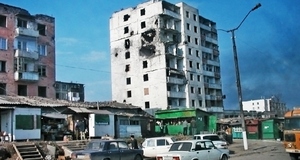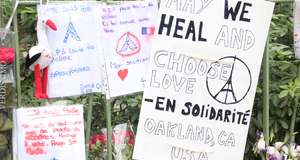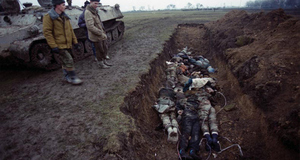Featured Article:Examining the Radicalization of Chechen Separatists During the Resistance Movement
By
2010, Vol. 2 No. 02 | pg. 1/2 | »
IN THIS ARTICLE
KEYWORDS
The Chechen people have endured a long history of aggression, culminating at the end of the twentieth century during which a separatist struggle against Russia began, triggering the First Chechen War in 1994. At the onset of the Second Chechen War however, it became apparent that Chechens were engaging in a different kind of warfare. In September of 1999, over 300 people were killed when Chechen terrorists destroyed apartment complexes in Moscow, Buinaksk, and Volgondosk. In 2002 and 2004, terrorists took hostages in a Moscow theater and in a middle school in Beslan, resulting in enormous massacres. While Boris Yeltsin started the First Chechen war with the aim of quelling separatism, Vladimir Putin shifted the aim during the Second Chechen War to fighting Russia’s own “war on terror.” To the Chechen people, the existence of their national identity, strongly intertwined with their Islamic faith, was being threatened. Part of the population succumbed to extremism, seeing brutal combat as the sole method of obtaining their objectives. The origins of this shift will be closely analyzed to clarify the misconceptions that have been purported by the Russian government and other intellectuals. Scholars have contended that radicalization developed out of Russian aggression during the First Chechen War. However, this represents a simplistic view of the conflict, neglecting to carefully examine all of the variables involved in the radical transformation. It is improbable that Russian aggression was the sole factor for the development of extremism, as this perception fails to acknowledge the intervention of outside actors and the intra-Chechen power struggle, as well as other factors that were present during both wars. Politicization of IslamScholars have purported that radicalization was in part due to the indissoluble bond between Islam and Chechen national identity, which has gradually strengthened over the course of the history. Starting from when Islam first came to the North Caucasus in the seventeenth century, a strong connection grew, and it became central in Chechen nationalism. Katrien Hertog (2005) provides a beneficial analysis of the beginnings of Chechen identity through her research. She postulates that during the two hundred years of Chechen resistance that began in the eighteenth century, the role of Islam grew more powerful in times of conflict with the Russian empire. In the years of resistance, groups of brotherhoods used jihad against Russia as a means to instate sharia law in the region. In response, Russia endeavored to subdue the brotherhoods, causing them to acquire an ideology of resistance that remained with them up until present times. From the start of the Soviet Union up until just before its collapse, religion was banned and so Chechens were forced to practice Islam behind closed doors.However, Islam flourished during this period and Chechens constantly resisted pressure to practice atheism under communist law. It was under the last decades of communism that the marriage between Islam and national identity occurred: during the 1970s and the 1980s religion, ethnic pride, anticommunism and anti-Russian feelings became so interlinked and mutually reinforcing among Chechens that it is impossible to separate one attitudinal strand from another (Hertog, 2005, para. 247). During the years of perestroika, the ban on Islam was lifted and Chechens were able to attend services and practice freely, although they became discriminated against for doing so. Although the Russian government has claimed that Islam and politics were merged from the beginning, since perestroika, Islam has remained outside of the political processes during the pre-war period, with the exception of two political parties, even though one did not have enough votes to enter the national congress and the other was never officially registered (Hertog, 2005, para. 240). It was under the threat of the 1994 war that this relationship between nationalism and religion became central in politics. Chechen leaders and warlords created narratives on national identity, using Islam to mobilize the civilian population in the struggle against Russia. These narratives played on the emotions of the population by making historical references to the religious and resistance wars of the past, leading to radicalization and the popularity of extremist views. As Emil Souleimanov (2005) states, in the Chechen mindset, a war against an external (Russian) aggressor is almost automatically associated with a war for territory, freedom, national honor, identity, and religion (p. 53). The leadership also relied upon the use of Islamic slogans to arouse the population into violence against Russia. Scholars report that it was solely through this close relationship between Islam and Chechen national identity that warlords were able to amass such radical support and carry out terrorist acts. However, Aurélie Campana (2006) has disagreed with this claim, as her research has postulated that warlords mobilized the population in order to achieve military and political goals and that most Chechens have expressed disgust over the use of terrorism (p. 137). Although research has shown that the number of civilians that were actually mobilized by these warlords is relatively small, their objective in recruiting fighters was successful regardless. Antagonism from Russian GovernanceWhile some scholars have maintained that the politicization of Islam was the main cause of Chechen radicalization, others believe it came out of the horrors and brutality that the population faced under Russian governance. Faced with the perseverance to maintain Chechnya, Russia used brutal tactics during the first war, radicalizing and unifying the Chechen population against it. Instilled in the Chechen national identity is the horrific mass deportation that was endured under Stalin in 1944, in which the whole population was expelled to Central Asia for their alleged cooperation with the Germans during the Second World War, even though this claim was largely false. According to Souleimanov (2005), during the First Chechen War, 35,000 to 100,000 civilians were estimated to have died (p. 48). The infrastructure and economy were obliterated, and public order broke down almost entirely. The reconstruction effort needed was massive, yet financial assistance and crucial resources were never received except for energy supplies and grain, resulting in the region descending into a state of disorder and lawlessness (Kramer, 2005, para. 210). Widespread poverty ensued, and high levels of unemployment among young adults, resulting in what Domitilla Sagramoso (2007) has described as “the resentment and disposition of people to violent political action when they share a sense that they have been deprived of economic opportunities or political advantages enjoyed by other groups (p. 690).” Russian troops engaged in systematic human rights abuses, including torture, rape, forced disappearances, mass arrest operations, kidnapping, and summary executions (Kramer, 2005, para. 214). As a result of these acts of horror, many saw no other option than to engage in illegal activities such as arms trafficking and kidnappings as a method of obtaining ransoms (Souleimanov, 2005, para. 49). Overall, it is obvious that Russian governance was ineffective and resulted in the alienation of the Chechen population from the rest of Russia, deepening separatist feelings and leading a section of the population to embrace violence as the only solution. The Role of Foreign FightersAnother group of scholars has stressed the role of foreign fighters from the Middle East in the Chechen conflict for the prevalence of extremist views. Cerwyn Moore and Paul Tumelty (2008) have conducted extensive research looking at the scope of foreign fighters present in Chechnya, in addition to their relationship with terrorist groups such as Al Qaeda. Foreign fighters can be described as “individual Muslims who make a conscious decision to join a grouping that is fighting occupation and/or aspiring for self-governance that denies their current national identity” (Moore & Tumelty, 2008, p. 414). Foreign fighters became widespread after the 1980s through the experience of the Mujahideen in Afghanistan, in which Islamist extremists worldwide identified with the ensuing conflict, motivating them to fight. During the First Chechen War, Shayk Fathi, a Jordanian Chechen, was one of the first compelled to go to Chechnya to help with their separatist struggle. There, he created an Islamic Assembly, gaining support and calling on the Chechens to wage jihad against Russia. Fathi then invited Amir Khattab, a Saudi-Afghan who had fought as a mujahideen in Afghanistan. Khattab built strong military links between foreign fighters and nationalist Chechens. Once he declared Chechnya appropriate for jihad, he won acceptance from the resistance movement and formed a close relationship with Shamil Basayev, leader of the Chechen resistance movement. In total, approximately eighty Arabs fought during the first war, as well as a small number of North Africans, Turks, and Central Asians. Following the end of the first war and the several years of de facto independence from 1996 to 1999, Khattab aspired for the creation of an Islamic state in Chechnya and established training camps where young adults took courses in religion and received military training (Kramer, 2005, para. 212).Continued on Next Page » Suggested Reading from Inquiries Journal
Inquiries Journal provides undergraduate and graduate students around the world a platform for the wide dissemination of academic work over a range of core disciplines. Representing the work of students from hundreds of institutions around the globe, Inquiries Journal's large database of academic articles is completely free. Learn more | Blog | Submit Latest in International Affairs |


















